Greetings, dear friends! In this brief article we will consider quite an interesting coincidence relating to the constellation of Canis Major (the Great Dog) where star Sirius is situated (1) and the discovered arrival direction of ultra-high-energy cosmic rays (2, 3). This article nearly duplicates a material published by the non-profit popular science project entitled Elements of Big Science, so below we will give relevant quotes and add some additional information.
“The Pierre Auger Collaboration reports observational evidence demonstrating that cosmic rays with energies a million times greater than that of the protons accelerated in the Large Hadron Collider come from much further away than from our own Galaxy. Ever since the existence of cosmic rays with individual energies of several Joules was established in the 1960s, speculation has raged as to whether such particles are created there or in distant extragalactic objects. The 50 year-old mystery has been solved using cosmic particles of mean energy of 2 Joules recorded with the largest cosmic-ray observatory ever built, the Pierre Auger Observatory in Argentina. It is found that at these energies the rate of arrival of cosmic rays is ~6% greater from one side of the sky than from the opposite direction, with the excess lying 120˚ away from the Galactic centre. By studying the distribution of the arrival directions of more than 30,000 cosmic particles the Auger Collaboration has discovered an anisotropy, significant at 5.2 standard deviations (a chance of about two in ten million), in a direction where the distribution of galaxies is relatively high. Although this discovery clearly indicates an extragalactic origin for the particles, the actual sources have yet to be pinned down.” (2)

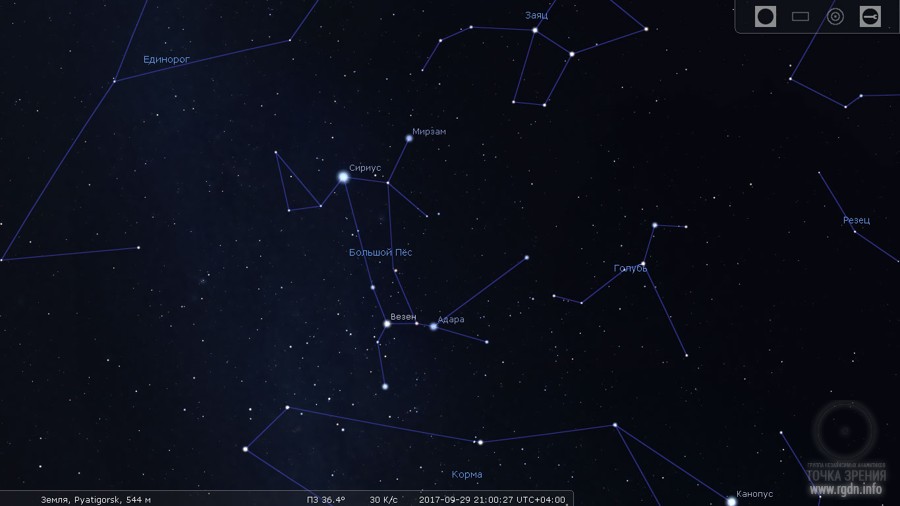
“Cosmic rays have been studied for about a hundred years. Exactly owing to cosmic rays, many outstanding discoveries have been made, e.g. the initial detection of positron, muon, π-meson and K-meson, hyperons, etc. For a long time before the emergence of large accelerators cosmic rays were the only source of energy-bearing elementary particles, whereas now astrophysics of high energies brings further new discoveries. As for ultra-high-energy cosmic rays of more than 1018 eV, one of the most intriguing riddles of modern physics has always been associated with them: their energy is so enormous that it is difficult even to imagine which astronomical processes such rays may emerge from.” (2)
“Cosmic rays may be classified by their energy. The thing is that from different sources there come cosmic rays of different energies, so such classification is quite natural. The greatest amount of cosmic rays originates from the Sun; their energy reaches approximately 10 GeV (1010 eV), and the flow consists of about 10,000 particles per second per square metre of the surface.” (2)
“Cosmic rays originating from various sources within our Galaxy bear energies of up to 1018 eV. At 1016 eV the flow consists of one particle per square metre a year. The most energy-intensive rays come to our planet from unknown sources beyond the Milky Way. They range between 1018 eV and 1020 eV. Such rays are usually called ultra-high-energy cosmic rays (UHECR). The number of such rays is very small: not more than one particle with the energy of 1020 eV may be expected per square kilometre within one century.” (2)
“Why do researchers believe that ultra-high-energy cosmic rays are of extragalactic origin? Because very strong and extensive magnetic fields are needed to accelerate particles to such energies. Roughly speaking, the stronger and more extensive a magnetic field is, the greater is the energy of particles accelerated in it. Moreover, researchers know very few reasons why such fields appear. Some objects, e.g. neutron stars or quasars, may produce giant fields. However, the size of such objects is rather limited. Other objects, i.e. galaxy accumulations, produce less intensive fields, but may cover millions of light years. Both types of objects are regarded as possible accelerators that produce ultra-high-energy cosmic rays, but none of them exist in our Galaxy. It is obvious in the case of galaxy accumulations. As for compact sources, everything is rather simple, too: if at least one such source existed in the Milky Way, arrival directions would be very heterogeneous pointing to the source, but no heterogeneity is observed. Hence, even before the publication of considered results physics had serious reasons to believe that ultra-high-energy cosmic rays are of extragalactic origin. At that, new data obtained by the Pierre Auger Observatory have finished the discussion.
So, there are no sources of ultra-high-energy cosmic rays in either the Milky Way or its close vicinity. Yet, where are they? Which monstrous sources accelerate particles to energies so enormous?
To find this out one should ascertain where these particles come from, which is not so simple because the flow of such particles is low. Estimation of the arrival direction of these particles (not to mention their concrete origin) requires relevant statistical data that may be obtained only when a considerable part of the Earth’s surface is observed.” (2)
“The Pierre Auger Observatory located near Malargüe in Argentina occupies an area of 3,000 km2. It was established especially for studying cosmic rays and cascades of secondary elementary particles engendered by such rays in the atmosphere, which are called cosmic-ray air showers.
Cosmic rays with energies of over 1014 eV engender air showers big enough to reach the Earth’s surface. When the energy of a ray is 1018 eV, the number of particles in the air shower reaches 1010. At that, the area of the air shower when it reaches the Earth is about 20 km2. The air shower spreads in the atmosphere at a speed close to the speed of light. At any moment in time the air shower particles are located within a rather thin disc that expands as it approaches the ground (see Figure 1).
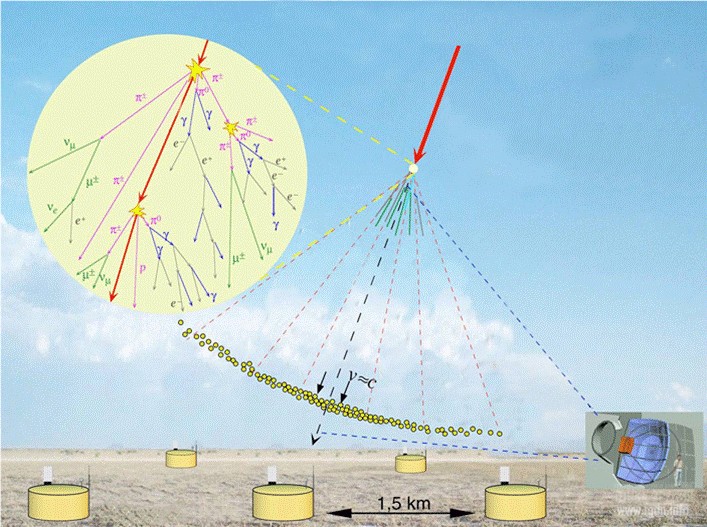
Figure 1. In the Pierre Auger Observatory, a shower of particles that emerges in the atmosphere when a cosmic ray passes through it is registered by means of surface detectors placed on the ground (yellow casks) and detectors of fluorescence that emerges in the atmosphere (on the right, below). The time of registration of a signal by surface detectors is indicative of the arrival direction of the initial ray. Featured from http://apcauger.in2p3.fr
The Pierre Auger Observatory uses two types of detectors – fluorescence and surface ones.
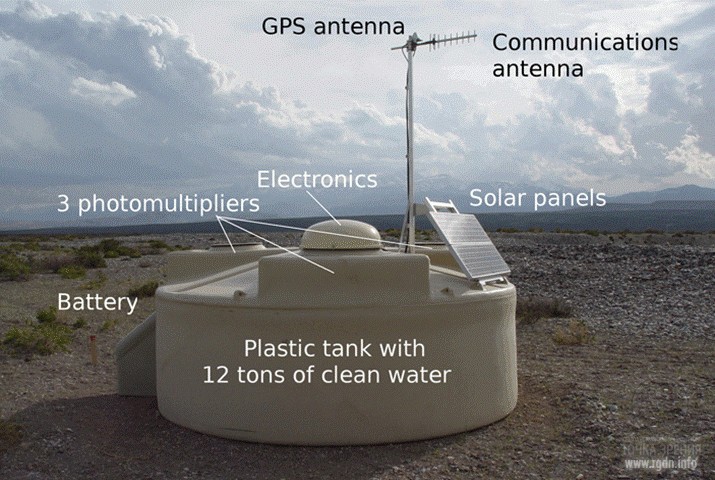
Figure 2. One of the surface detectors of the Pierre Auger Observatory. Image from the article Observation of Ultra-High Energy Cosmic Rays by R. Smida, 2010
It is noteworthy that once a disc of particles reaches the ground the signal on different detectors emerges at different times. This makes it possible to ascertain the direction from where the air shower has arrived, with a precision of up to 1°. Such precision may seem not very significant (e.g. 1° is a value twice greater than the angular size of the Moon). Yet, in this particular case this proves to be sufficient. On their way through space and especially across our Galaxy cosmic rays deflect in magnetic fields they encounter, and the angle of such deflection is proportional to the particle charge. The charge of ultra-high-energy cosmic rays is 1.7 to 5 proton charge units on average (here we call particles not only protons but nuclei, too: cosmic rays contain nuclei of chemical elements down to iron). Depending on the arrival direction of a particle relative to the Milky Way’s magnetic field, the angle of deflection may be up to several tens of degrees. Knowing the Galaxy’s magnetic field, it would be possible to ascertain the true arrival direction as it was before the deflection within the magnetic field. However, available models of the Milky Way’s magnetic field so far do not allow such analysis with relevant precision. In any case the current precision of arrival direction estimation in the discussed experiment is better than the precision we can achieve in principle. Moreover, our priority task is to detect at least some heterogeneity in arrival directions of ultra-high-energy cosmic rays, and for this no better precision is needed.
The discussed article contains data taken from surface detectors at the Pierre Auger Observatory. Every such detector is a cylindrical plastic tank with highly purified water, 12 m3 in volume and 1.2 m in depth, with the base area of 10 m2. The tank contains three 9-inch photomultipliers that register Cherenkov radiation emerging in the water when an air shower passes through it. Photomultipliers are fed via solar panels (and a battery at night). The read signal is transmitted by radio. Signals from different detectors are synchronised via GPS.” (2)
“Figure 3 features distribution of a flow of cosmic rays with energies of over 8×1018 eV across the celestial sphere at equatorial coordinates.
The red area means a higher-energy flow, and the blue area means lower energies.
The only fact that the upper limit of such distribution is far from the Galactic Centre direction is already indicative of an extragalactic origin of such cosmic rays. Furthermore, when energies are between 4×1018 eV and 8×1018 eV no heterogeneity of the flow has been detected. This is due to the fact that the angle of deflection of cosmic rays in the Galaxy’s magnetic field at such energies is very broad, so we are simply unable to observe heterogeneity of their arrival directions. This is another evidence of an extragalactic origin of ultra-high-energy cosmic rays. After all, should any heterogeneity in arrival directions be detected, this would prove such particles are engendered within our Galaxy and not beyond it. Please, note that heterogeneity is very small in numerical expression: the blue and red areas correspond to close values (see numbers at the colour scale). For this very reason it took us 12 years to discover heterogeneity. Here we can see the results of the analysis of data collected between 2004 and 2016.
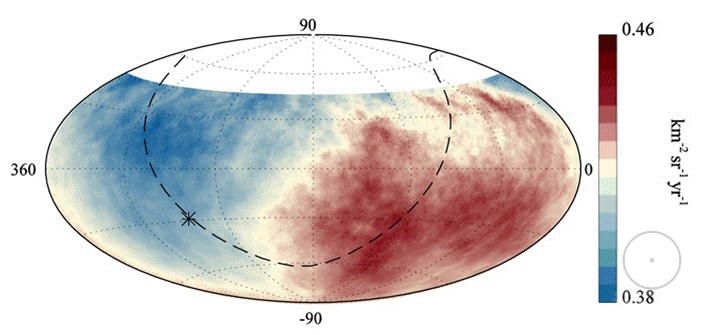
Figure 3. Distribution of a flow of cosmic rays with energies of over 8×1018 eV across the celestial sphere at equatorial coordinates. The Milky Way’s plane is represented by a dotted line where the asterisk points at the Galactic Centre. The white circle around the North Pole signifies an area unobservable from the Pierre Auger Observatory location. Image from an article in Science
Figure 3 depicts distribution of arrival of cosmic rays by galactic coordinates. The red area centre indicates the direction from where ultra-high-energy cosmic rays mostly arrive. The coordinates of this direction are 100° right ascension and −24° declination with a statistical significance of 5,4σ. The flow of cosmic rays from the red area is 6.5% higher than the flow from the blue area.” (2)
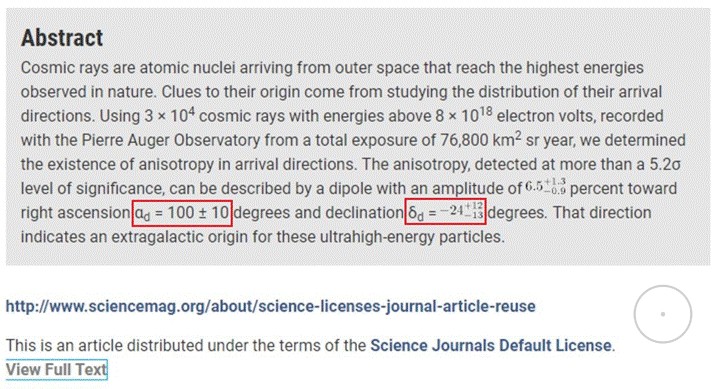
Figure 4. Abstract from a research article with coordinates marked
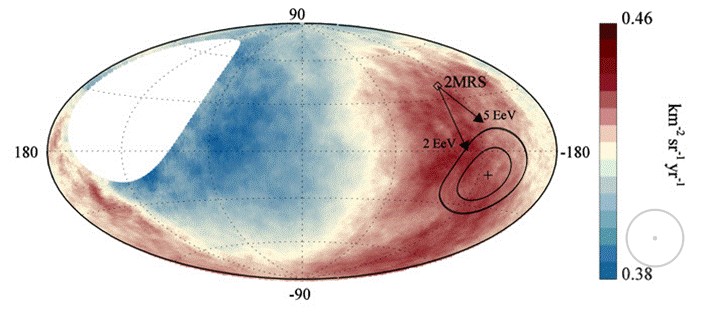
Figure 5. Data by galactic coordinates. Direction towards the Galactic Centre is in the middle. The cross marks direction to the red area centre. The two outlines around the cross mark 68-percent and 95-percent confidence intervals. The image shows direction to the upper limits of distribution of galaxies according to the 2MASS Redshift Survey / 2MRS (the rhombus), whereas arrows show how particles with energies of E/Z = 2×1018 eV and 5×1018 eV, which arrive from this direction, deflect from the Milky Way’s magnetic field. (2)
These very coordinates (the right ascension of 100° and the declination of f –24° (4)) appear quite interesting. By means of Stellarium software (5) it is easy to determine the point in the stellar sky with such coordinates (see Figures 6 and 7).
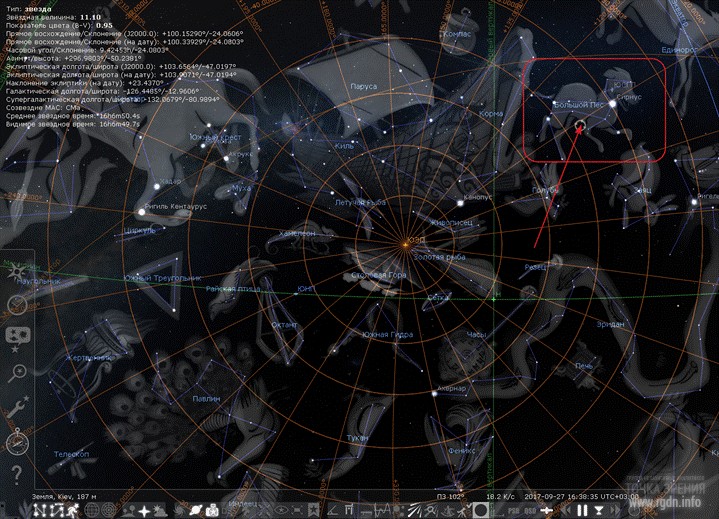
Figure 6. Direction towards the centre of the maximal flow of ultra-high-energy cosmic rays (star Sirius in the constellation of Canis Major)
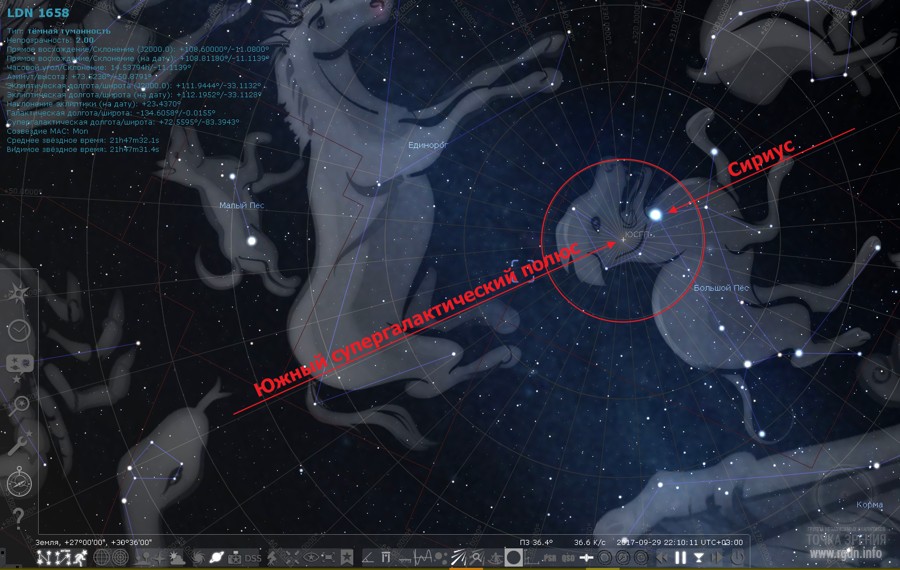
Figure 7. Sirius coordinates are very close to those of the South Supergalactic Pole
“The obtained results do not clearly indicate the nature of ultra-high-energy cosmic rays. It may be assumed that the distribution of sources of such rays approximately matches the distribution of galaxies in the Universe where there is heterogeneity, for galaxies in the Milky Way vicinity are distributed very heterogeneously. In the area marked with the rhombus on Image 5 the observed number of galaxies is somewhat bigger than the average. This direction is 55° away from the red area centre. However, if we take into account the Galaxy’s magnetic field that deflects the rays (in Image 5 such deflection is marked with arrows), it turns out the data on the direction of the maximal flow of cosmic rays and on the distribution of galaxies match. That is, the shift in the arrival directions of cosmic rays may be explained simply by deflection of cosmic rays in the Milky Way’s magnetic field. This evidences the correctness of our assumption that the distribution of cosmic ray sources and the distribution of galaxies coincide, although it is so far totally unclear what those sources are – quasars, galaxy accumulations or something else.” (2)
“These results may seem not very impressive, but it’s a significant success indeed. The official speaker of the Pierre Auger Observatory Professor Karl-Heinz Kampert expressed the following opinion on the experiment, “We have become much closer to a solution to the issue so interesting for astrophysicists – the riddle where and how these extraordinary particles arise. Our observations provide incontrovertible evidence that the places where such particles accelerate are beyond the Milky Way.” Professor Alan A. Watson, distinguished scientist and one of the experiment founders, regards this result as one of the most impressive of all results obtained by the Pierre Auger Collaboration. Indeed, for over 50 years the nature of ultra-high-energy cosmic rays has been a total riddle to physicists, and now a clue to it has been approached for the first time.
The next step is to compare arrival directions of cosmic rays with catalogues of various objects in the Universe. If a correlation with a certain type of objects is found, it will be clear where we should further move. Hopefully, soon a day will come when we will finally discover which exactly astronomical monster accelerates particles to ultra-high energies.”
Source: The Pierre Auger Collaboration. Observation of a Large-Scale Anisotropy in the Arrival Directions of Cosmic Rays above 8×1018eV // Science. 2017. V. 357. DOI: 10.1126/science.aan4338. Mikhail Stolpovsky (2)
Interestingly enough, it has been ascertained that protons make up 92% of cosmic rays (see Figure 8).
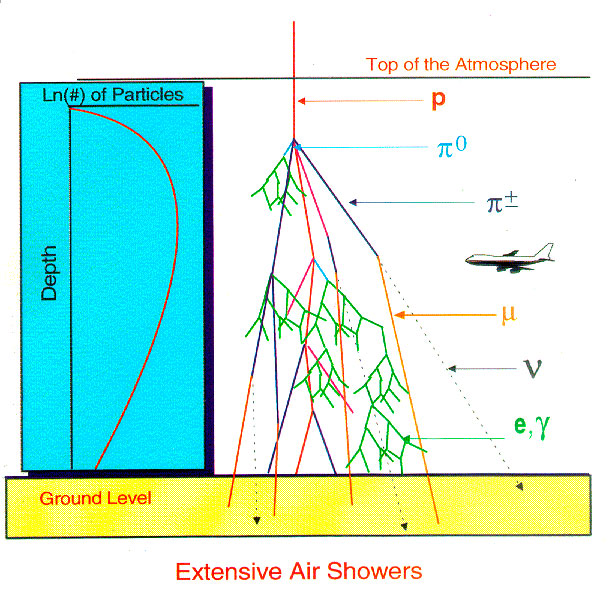
Figure 8. Air showers
“According to NASA, 98% of particles in cosmic rays are baryons (protons and alpha particles – helium nuclei). When these particles come into collision with gas atom nuclei in the atmosphere, they beget numerous splinters, charged and neutral particles which in their turn collide with atom nuclei, disintegrate and cause “air showers”. (6)
NASA data published in 2010 indicate that flows of charged cosmic particles contain 98% of baryons and only 2% of stable leptons (electrons and positrons). The baryon component in its turn contains protons (87%), alpha particles (12%) and nuclei of chemical elements heavier than helium, which astronomers refer to as metals (1%). The most widespread of those are carbon, nitrogen and oxygen, followed by lithium, beryllium and boron. These six elements make up about 90% of “cosmic metals”, while all the rest have just a minimal share. About four fifths of the rest of particles represent elements with atomic numbers 9 through 25, located between oxygen and iron in the periodic table. Almost the entire remainder is occupied by iron sided by nickel and cobalt. The total share of elements heavier than cobalt is one hundred thousandth of one percent, but they are still found. Thus, it has been discovered that primary cosmic rays contain nuclei of gold, mercury, platinum, lead, and even uranium. On the other hand, there are no radioactive elements with a short lifetime.” (6)
Now let’s refer to several quotes from the books by Anastasia Novykh, where star Sirius is mentioned:
“…Now scientists call it the Baalbek Veranda. It’s a huge platform built of gigantic blocks, each weighing 360 tons, with special holes on each side of the platform. Archaeologists still rack their brains over its purpose, though unlike world-views of people from previous epochs they started at least to guess that it looks like a cosmodrome,” Sensei grinned. “Their naivety is striking! They look for traces of soot from spaceship fuel and mean by fuel the one with components known nowadays.” Sensei stated with surprise. “What kind of tanks should one have with such fuel in order to go to, for instance, Sirius and to come back?! They are so ridiculous; they look for traces of fuels and lubricants and don’t even assume there are lots of other sources of alternative energy which are more economical and environmentally friendly. Well, as they say, one relies on information available to him.” (Sensei of Shambala – Book IV by A. Novykh)
“Besides the Baalbek Veranda, there were other cosmodromes that didn’t require such a big takeoff-and-landing site. There was a region at the very base of the Nile ‘flower’ for such spaceships. Naturally, such intensive traffic was noticed by people. That is why quite interesting ancient legends about that time were preserved in the memory of generations.”
“Which legends, for example?” Nikolai Andreevich asked.
“For example, legends about an ancient city of Khem that was later called Letopolis by Greeks. It was situated near the ‘flower base’ on the western bank of the Nile Rosette Arm. There are some legends that in antiquity it was called a ’city of thunderbolt’, and according to religious sources Khem is known as ‘the road sign that shows Osiris’s way to the sky’. This city was considered to be an earthly reflection of Sirius.” (Sensei of Shambala – Book IV by A. Novykh)
Even with modern equipment one can trace how brain activity reorganizes itself in an altered state of consciousness. When a person thinks in the ordinary state of consciousness, activity of the nerve cells in different areas of the brain appears similar to a stellar sky, i.e. scattered. But when a person is in an altered state of consciousness, then an entirely different picture of brain activity is formed. The “stars” sort of line up in the form of peculiar “star clusters” of certain shapes – spheres, clouds, streams and beams having a clear direction. (AllatRa by A. Novykh)
“... And that He hath ordained the second bringing forth;
And that He it is Who enricheth and contenteth;
And that He it is Who is the Lord of the great planet ash-Shi’ra…’
or to put it clearer: ‘And that He is the only Lord of Sirius (the Might)’. The thing is that Arabs call Sirius, the brightest star on the sky in the constellation of Canis Major, ‘ash-Shi’ra al-Yamaniya’. It was called so even three thousand years ago so.”
…
“These are the signs for those who know.” And he summarized as if nothing happened. “So, the knowledge about the World Mountain was spread almost all over the world. At that, the main thing is that this knowledge didn’t lie dormant, but was practiced.” (Sensei of Shambala – Book IV by A. Novykh)
… as a matter of fact, the meaning of Allat is universal. Actually it is a word of extraterrestrial origin. It came to us, as I have already said, from Phaeton, to Phaeton from Sirius, and to Sirius it had come from more advanced civilizations. In its essence, allat means a common unit – a precursor of time. (Sensei of Shambala – Book IV by A. Novykh)
“Oh, it’s quite an interesting point,” Sensei said. “In Ancient Egypt ’Shu’ was a term to denote a human ‘shadow’, basically one of Ka manifestations. As for ‘Sakh’… Let’s put it so, the word Sakh had several meanings in Ancient Egypt. Sakh meant enlightenment. The same word referred to the Orion constellation which they considered to be the king of stars. By the way, they often attached the name of Orion also to Osiris, while his spouse Isis was called Sotis (star Sirius, the closest to the Earth). Sakh also meant a special state of a human being at the moment of the highest ‘enlightenment’. Then they began to call so the ‘blessed ancestors’, ‘noble people of antiquity’, and later on attributed the term Sakh to people from the palace aristocracy who were authorized to carry seals.” (Sensei of Shambala – Book IV by A. Novykh)
“Do you see how long this chain of human transformations and fantasies is? Yet, everything was simple in the beginning. Ancient Egyptians initially explained Sakh as life-giving energy. Owing to the Sakh-Ba-Shu state as it was called by ancient Egyptians, or saying in our language by means of a certain spiritual practice, a person achieved a special state of the ‘highest enlightenment’. Pyramidal structures played a great role in that as one of preconditions for this practice on achievement of such a state of ‘enlightenment’. First those were stone pyramidal buildings or hills. By the way, later on this was one of the reasons why ancient Egyptians worshipped the sacred pyramid-shaped stone Ben Ben.
Incidentally, this spiritual practice wasn’t limited only to Ancient Egypt. Many artificially built pyramids discovered nowadays by modern humanity, as well as those that are still ‘sealed’ and not found, are far from being chaotic buildings. Though built in different times, they were placed in strictly determined coordinates, with strict orientation at certain stars as of the time of construction. Globally it’s a sort of a map. Creation of such pyramids was initiated by people who possessed relevant knowledge, e.g. Imhotep. He received information about the global architectural project (elaborated way before the time of Imhotep) from Sokrovennik, at the end of his several-year learning from him, along with other knowledge.” (Sensei of Shambala – Book IV by A. Novykh. Information about SAKH-BA-SHU hypothesis may be found on our website.)
At that, taking into account that cosmic rays mostly consist of protons which are somehow connected with the Human Front Aspect, a very interesting picture actually arises…
Sources:
Prepared by X-ray (Hamburg, Germany)
 Sirius and ultra-high-energy cosmic rays
votes:
148
Sirius and ultra-high-energy cosmic rays
votes:
148
|

Project Aim










Leave comment